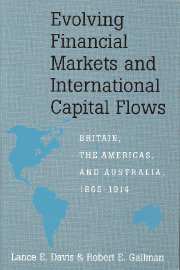 Evolving Financial Markets and International Capital Flows
Evolving Financial Markets and International Capital Flows Published online by Cambridge University Press: 18 August 2009
Introduction
History and current events
No one believes that history repeats itself exactly, but many economic historians must have nodded knowingly when they opened their morning newspapers on February 27, 1995. On that day newspapers throughout the world reported that the House of Baring – one of the world's oldest private banks – had gone into bankruptcy. Over one hundred years earlier, in 1890, Barings had also teetered on the verge of bankruptcy. The cases are remarkably similar. Not only did the two crises involve the same institution, but in both cases Barings was involved in financial operations in the less-developed world. In 1890 it was Latin America, particularly Argentina and Uruguay. One hundred and five years later the newspapers reported that Barings was a “strong niche player in the emerging markets of Asia, Latin America, Africa and Eastern Europe.” Moreover, despite the passage of time and the growth in the size of the British economy, the magnitudes of the potential losses, then and now, are not dissimilar. In 1890, £17.25 million was sufficient to cover Barings potential liabilities; in today's dollars that figure amounts to just over $850 million. In 1995, if the press is to be believed, the funds required to save “the world's oldest private bank” fell in the $950 million to $1.27 billion range.
To save this book to your Kindle, first ensure [email protected] is added to your Approved Personal Document E-mail List under your Personal Document Settings on the Manage Your Content and Devices page of your Amazon account. Then enter the ‘name’ part of your Kindle email address below. Find out more about saving to your Kindle.
Note you can select to save to either the @free.kindle.com or @kindle.com variations. ‘@free.kindle.com’ emails are free but can only be saved to your device when it is connected to wi-fi. ‘@kindle.com’ emails can be delivered even when you are not connected to wi-fi, but note that service fees apply.
Find out more about the Kindle Personal Document Service.
To save content items to your account, please confirm that you agree to abide by our usage policies. If this is the first time you use this feature, you will be asked to authorise Cambridge Core to connect with your account. Find out more about saving content to Dropbox.
To save content items to your account, please confirm that you agree to abide by our usage policies. If this is the first time you use this feature, you will be asked to authorise Cambridge Core to connect with your account. Find out more about saving content to Google Drive.